17 UMMA Objects
17 UMMA Objects
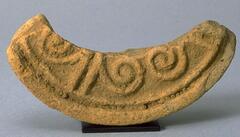
Chinese (Chinese (culture or style))
Roof Tile
2nd century
Gift of Dr. and Mrs. Peter Greiner
1979/2.7
![Earthenware roof tile-end with molded lotus design.<br />
<br />
This gray, high-fired earthenware convex eave-end roof tile features a slender thirteenpetal lotus design. It is made from coarse clay mixed with small stone particles. The circular ovary and lotus seeds are depicted in shallow relief, while the lotus petals are slender and lack volume.<br />
[Korean Collection, University of Michigan Museum of Art (2017) p.36] Earthenware roof tile-end with molded lotus design.<br />
<br />
This gray, high-fired earthenware convex eave-end roof tile features a slender thirteenpetal lotus design. It is made from coarse clay mixed with small stone particles. The circular ovary and lotus seeds are depicted in shallow relief, while the lotus petals are slender and lack volume.<br />
[Korean Collection, University of Michigan Museum of Art (2017) p.36]](/media/W1siZiIsIjIwMjIvMDkvMjQvOXVkYnJyYnlyaV9kZWZhdWx0LmpwZyJdLFsicCIsInRodW1iIiwiMjQweDIwMCJdXQ?sha=8f6c2bf6c7b8db77)
Korean (Korean (culture or style))
Roof Tile-End with Lotus Design
676 – 935
Gift of Bruce and Inta Hasenkamp and Museum purchase made possible by Elder and Mrs. Sang-Yong Nam
2004/1.196
![This lotus medallion design on this round tile-end consists of eight petals. The outer rim is decorated with eighteen round dents. The seedpod contains six peripheral seeds.<br />
<br />
This gray, high-fired earthenware convex eave-end roof tile features a single-tier lotus design. It is made from fine clay mixed with a small amount of sand and is robust in appearance. The central ovary and petals of the lotus stand out in relief. The rim displays a “pearl-dot” (<em>yeonju</em> ) motif depicted in intaglio.<br />
[Korean Collection, University of Michigan Museum of Art (2017) p.36] This lotus medallion design on this round tile-end consists of eight petals. The outer rim is decorated with eighteen round dents. The seedpod contains six peripheral seeds.<br />
<br />
This gray, high-fired earthenware convex eave-end roof tile features a single-tier lotus design. It is made from fine clay mixed with a small amount of sand and is robust in appearance. The central ovary and petals of the lotus stand out in relief. The rim displays a “pearl-dot” (<em>yeonju</em> ) motif depicted in intaglio.<br />
[Korean Collection, University of Michigan Museum of Art (2017) p.36]](/media/W1siZiIsIjIwMjIvMDkvMjQvMmdrajdidWp4Ml9kZWZhdWx0LmpwZyJdLFsicCIsInRodW1iIiwiMjQweDIwMCJdXQ?sha=9077af1495ff16b4)
Korean (Korean (culture or style))
Roof Tile
676 – 935
Gift of Bruce and Inta Hasenkamp and Museum purchase made possible by Elder and Mrs. Sang-Yong Nam
2004/1.197
![This is an example of a lotus medallion with a double layer of petal. Two rows of eight petals each are arranged around a double-ring seedpod. The outer ring of the seedpod has no design. The inner ring of the seedpod contains a central seed surrounded by six peripheral seeds (1+6 seed pattern). The outer rim is embellished with a bead pattern.<br />
<br />
This gray-white, high-fired earthenware concave eave-end roof tile with an eight-petal lotus design was made from fine clay mixed with a small amount of sand. The reverse side shows signs of having been joined to a flat tile, while traces of trimming and smoothing with water are also visible. The round ovary is circumscribed by double lines and contains seven seeds: one in the center surrounded by six more.<br />
[Korean Collection, University of Michigan Museum of Art (2017) p.37] This is an example of a lotus medallion with a double layer of petal. Two rows of eight petals each are arranged around a double-ring seedpod. The outer ring of the seedpod has no design. The inner ring of the seedpod contains a central seed surrounded by six peripheral seeds (1+6 seed pattern). The outer rim is embellished with a bead pattern.<br />
<br />
This gray-white, high-fired earthenware concave eave-end roof tile with an eight-petal lotus design was made from fine clay mixed with a small amount of sand. The reverse side shows signs of having been joined to a flat tile, while traces of trimming and smoothing with water are also visible. The round ovary is circumscribed by double lines and contains seven seeds: one in the center surrounded by six more.<br />
[Korean Collection, University of Michigan Museum of Art (2017) p.37]](/media/W1siZiIsIjIwMjIvMDkvMjQvNWQ2NmVjeHQzYl9kZWZhdWx0LmpwZyJdLFsicCIsInRodW1iIiwiMjQweDIwMCJdXQ?sha=4c7124ce9509ddf0)
Korean (Korean (culture or style))
Roof Tile
676 – 935
Gift of Bruce and Inta Hasenkamp and Museum purchase made possible by Elder and Mrs. Sang-Yong Nam
2004/1.198
![Circular earthenware tile with molded lotus and bosangwha design.<br />
<br />
This dark gray, high-fired earthenware convex eave-end roof tile is decorated with an eight-petal lotus floral medallion. It is made from coarse clay mixed with fine stone particles. The center of the tile is decorated with a double-petaled lotus flower surrounded by eight heart-shaped palmette petals (bosanghwa ) in low relief. Traces of clay used to attach this tile to a flat tile can also be seen on the joints of the reverse side.
<p>[Korean Collection, University of Michigan Museum of Art (2017) p. 39]</p>
Circular earthenware tile with molded lotus and bosangwha design.<br />
<br />
This dark gray, high-fired earthenware convex eave-end roof tile is decorated with an eight-petal lotus floral medallion. It is made from coarse clay mixed with fine stone particles. The center of the tile is decorated with a double-petaled lotus flower surrounded by eight heart-shaped palmette petals (bosanghwa ) in low relief. Traces of clay used to attach this tile to a flat tile can also be seen on the joints of the reverse side.
<p>[Korean Collection, University of Michigan Museum of Art (2017) p. 39]</p>](/media/W1siZiIsIjIwMjIvMDkvMjQvM255Z3pueDhnNl9kZWZhdWx0LmpwZyJdLFsicCIsInRodW1iIiwiMjQweDIwMCJdXQ?sha=7079d07ccd567174)
Korean (Korean (culture or style))
Roof Tile-End with Lotus and Bosanghwa Design
676 – 935
Gift of Bruce and Inta Hasenkamp and Museum purchase made possible by Elder and Mrs. Sang-Yong Nam
2004/1.201
![The decoration of this tile-end consists of lotus medallion with eight petals in the center surrounded by eight heart-shaped bosanghwa(Buddhist floral pattern) just inside the rim. The rim is decorated with a chain of beads.<br />
<br />
This yellowish gray, high-fired earthenware convex eaveend roof tile features an eight-petal lotus floral medallion design. It is made from fine clay and robust in appearance. The tile features a central two-tier, eight-petal lotus design, surrounded by a palmette (or bosanghwa ) design, consisting of eight heart-shaped petals, in low relief.
<p>[Korean Collection, University of Michigan Museum of Art (2017) p. 40]</p>
<br />
The decoration of this tile-end consists of lotus medallion with eight petals in the center surrounded by eight heart-shaped bosanghwa(Buddhist floral pattern) just inside the rim. The rim is decorated with a chain of beads.<br />
<br />
This yellowish gray, high-fired earthenware convex eaveend roof tile features an eight-petal lotus floral medallion design. It is made from fine clay and robust in appearance. The tile features a central two-tier, eight-petal lotus design, surrounded by a palmette (or bosanghwa ) design, consisting of eight heart-shaped petals, in low relief.
<p>[Korean Collection, University of Michigan Museum of Art (2017) p. 40]</p>
<br />
](/media/W1siZiIsIjIwMjIvMDkvMjQvN2Vzb3hndzhtal9kZWZhdWx0LmpwZyJdLFsicCIsInRodW1iIiwiMjQweDIwMCJdXQ?sha=a11d47260113b54c)
Korean (Korean (culture or style))
Roof Tile
676 – 935
Gift of Bruce and Inta Hasenkamp and Museum purchase made possible by Elder and Mrs. Sang-Yong Nam
2004/1.202
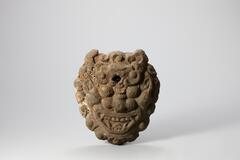
Korean (Korean (culture or style))
Ogre tile from the roof of the Great South Gate (Namdaemon) of Seoul
1391 – 1401
Gift of Bruce and Inta Hasenkamp and Museum purchase made possible by Elder and Mrs. Sang-Yong Nam
2004/1.259
![This lotus medallion designed on this round tile-end consists of thirteen petals. The outer rim is decorated with eighteen round dents. The inner ring of the seedpod contains a big central seed surrounded by seven peripheral seeds. The outer rim is embellished with a bead pattern.<br />
<br />
This gray-white, low-fired earthenware tile features a single-tier, thirteen-petal lotus design and is made from fine clay. The large lotus seed at the center of the ovary is surrounded by seven slightly smaller seeds. Evidence of repair using gray clay is visible on the reverse side of the tile.<br />
[Korean Collection, University of Michigan Museum of Art (2017) p.37] This lotus medallion designed on this round tile-end consists of thirteen petals. The outer rim is decorated with eighteen round dents. The inner ring of the seedpod contains a big central seed surrounded by seven peripheral seeds. The outer rim is embellished with a bead pattern.<br />
<br />
This gray-white, low-fired earthenware tile features a single-tier, thirteen-petal lotus design and is made from fine clay. The large lotus seed at the center of the ovary is surrounded by seven slightly smaller seeds. Evidence of repair using gray clay is visible on the reverse side of the tile.<br />
[Korean Collection, University of Michigan Museum of Art (2017) p.37]](/media/W1siZiIsIjIwMjIvMDkvMjQvMjdyMTQzYWJvMF9kZWZhdWx0LmpwZyJdLFsicCIsInRodW1iIiwiMjQweDIwMCJdXQ?sha=8f0ef0df9c2ac975)
Korean (Korean (culture or style))
Roof Tile
676 – 935
Gift of Bruce and Inta Hasenkamp and Museum purchase made possible by Elder and Mrs. Sang-Yong Nam
2004/1.199
![It is a fragment of roof-end tile with apsara design in relief.<br />
<br />
This fragment of a red-brown, high-fired concave eave-end roof tile features a <em>bicheon</em> or <em>apsaras</em> (a celestial being of the clouds and waters in Hindu and Buddhist mythology) design. It is made from fine clay, resulting in a smooth surface and robust appearance. The left part of the tile is no longer present; only the heavenly cloth and cloud design remain. The narrow upper and lower rims of this tile are bordered with rows of dots, while the left and right edges have no rim. Clear traces of trimming and smoothing with water are visible on the edges and back of the tile.<br />
[Korean Collection, University of Michigan Museum of Art (2017) p.36] It is a fragment of roof-end tile with apsara design in relief.<br />
<br />
This fragment of a red-brown, high-fired concave eave-end roof tile features a <em>bicheon</em> or <em>apsaras</em> (a celestial being of the clouds and waters in Hindu and Buddhist mythology) design. It is made from fine clay, resulting in a smooth surface and robust appearance. The left part of the tile is no longer present; only the heavenly cloth and cloud design remain. The narrow upper and lower rims of this tile are bordered with rows of dots, while the left and right edges have no rim. Clear traces of trimming and smoothing with water are visible on the edges and back of the tile.<br />
[Korean Collection, University of Michigan Museum of Art (2017) p.36]](/media/W1siZiIsIjIwMjIvMDUvMjUvMnhzNjhzNDE3X2RlZmF1bHQuanBnIl0sWyJwIiwidGh1bWIiLCIyNDB4MjAwIl1d?sha=798790b7fb889401)
Korean (Korean (culture or style))
Ceramic roof tile with fragment of apsara, cloud designs
676 – 935
Gift of Dr. and Mrs. Peter Greiner
1979/2.3
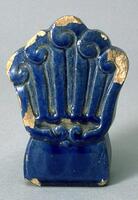
Chinese (Chinese (culture or style))
Blue glazed roof tile from the Temple of Heaven, Beijing
1650 – 1799
Gift of Dr. and Mrs. Peter Greiner
1979/2.5
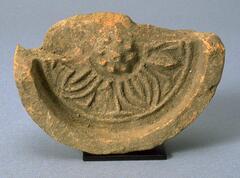
Chinese (Chinese (culture or style))
Roof Tile
7th century
Gift of Dr. and Mrs. Peter Greiner
1979/2.6
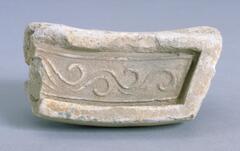
Japanese (Japanese (culture or style))
Ceramic roof tile from Tôshôdaiji
767 – 799
Gift of Dr. and Mrs. Peter Greiner
1979/2.4
Loading…
